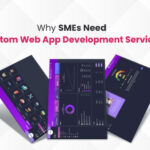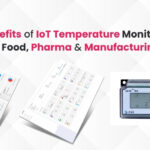In industries like food, pharmaceuticals, and manufacturing, temperature isn’t just a number – it’s a key factor that determines quality, safety, and compliance. Even slight fluctuations can lead to product spoilage, loss, or equipment damage. That’s why more companies are turning to IoT Temperature Monitoring systems to gain real-time control and visibility over their operations.
IoT (Internet of Things) solutions connect temperature sensors, gateways, and analytics platforms to provide continuous data insights. These systems help businesses make smarter, faster, and more informed decisions while ensuring safety and compliance.
Let’s explore the top 7 benefits of IoT temperature monitoring across these critical sectors.
1. Real-Time Monitoring and Alerts
Traditional temperature monitoring methods rely on manual checks that are time-consuming and prone to human error. With IoT Temperature Monitoring, sensors transmit live data to a centralized platform, allowing teams to monitor multiple locations simultaneously.
When a reading crosses a threshold, automatic alerts via SMS or email are triggered – enabling immediate corrective action before damage occurs. This real-time visibility ensures that sensitive materials remain within safe parameters 24/7.
2. Ensuring Product Quality and Safety
In food and pharmaceutical industries, maintaining specific temperature ranges is crucial for product integrity. IoT-enabled systems continuously track storage and transit conditions to ensure compliance with quality standards.
For example:
- In food processing, IoT monitors refrigeration units and cold chains to prevent spoilage.
- In pharmaceutical manufacturing, it ensures vaccines, medicines, and lab samples remain effective by maintaining stable environments.
By automating data collection, IoT eliminates guesswork and upholds safety at every stage.
3. Compliance with Industry Regulations
Both the food and pharma industries operate under strict regulatory frameworks such as FSSAI, FDA, and WHO standards. IoT temperature monitoring systems automatically record temperature logs, create audit trails, and generate digital reports for compliance verification.
This not only reduces the burden of manual documentation but also ensures accuracy during inspections or audits. Regulatory compliance becomes easier, faster, and more transparent.
4. Predictive Maintenance and Equipment Efficiency
IoT sensors don’t just monitor temperature – they also help predict equipment failures. If a refrigeration unit or furnace starts deviating from its optimal range, the system flags it early, allowing preventive maintenance before major breakdowns occur.
In manufacturing environments, this predictive capability minimizes downtime, reduces repair costs, and extends the life of critical machinery.
5. Cost Savings Through Energy Optimization
Energy efficiency is another major advantage of IoT temperature monitoring. Smart sensors and controllers can automatically adjust cooling or heating systems based on real-time demand.
For instance, if a cold storage door remains open longer than expected, the system can alert staff or compensate by adjusting airflow. Over time, this reduces electricity wastage and operational costs while maintaining consistent conditions.
6. Centralized Data Analytics for Better Decision-Making
IoT platforms collect massive amounts of temperature data that can be analyzed for trends and insights. Businesses can use these analytics to:
- Identify inefficiencies in production or logistics.
- Optimize energy use based on real-time behavior patterns.
- Improve forecasting and inventory management.
In essence, IoT transforms raw temperature readings into actionable intelligence – helping leaders make data-driven decisions that improve efficiency and profitability.
7. Enhanced Supply Chain Transparency
In industries with complex supply chains, like frozen foods or pharmaceuticals, tracking temperature across multiple transit points is critical. IoT-enabled devices ensure complete visibility from production to delivery.
Real-time data sharing between manufacturers, logistics providers, and retailers builds trust and accountability throughout the supply chain. Customers and regulators can verify that goods have been stored and transported under optimal conditions at all times.
Final Thoughts
IoT Temperature Monitoring is no longer a luxury – it’s an operational necessity. It ensures consistent product quality, compliance, and efficiency while reducing costs and risks.
At Proses, we design and implement smart IoT-based monitoring solutions that empower businesses in food, pharma, and manufacturing to work smarter and safer. Our integrated systems provide accurate insights, real-time control, and seamless automation to help you stay ahead in a competitive market.
Ready to modernize your operations with IoT intelligence?
https://www.prosesindia.com/



